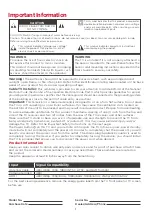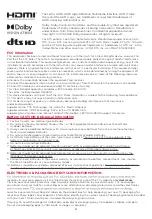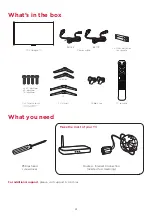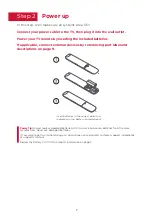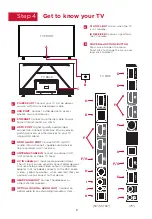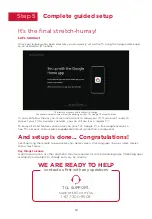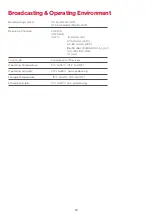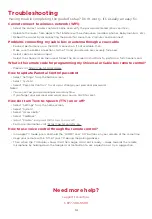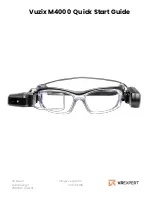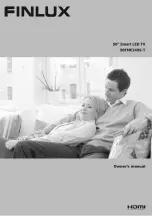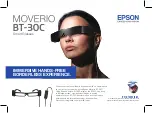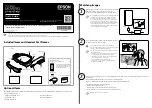
3
FCC Information
This equipment has been tested and found to comply with the limits for a Class B digital device, pursuant to
Part 15 of the FCC Rules. These limits are designed to provide reasonable protection against harmful interference
in a residential installation. This equipment generates, uses, and can radiate radio frequency energy and, if not
installed and used in accordance with the instructions, may cause harmful interference to radio communications.
However, there is no guarantee that interference will not occur in a particular installation. If this equipment does
cause harmful interference to radio or television reception, which can be determined by turning the equipment o
and on, the user is encouraged to try to correct the interference by one or more of the following measures:
Reorient or relocate the receiving antenna.
Increase the separation between the equipment and receiver.
Connect the equipment into an outlet on a circuit di erent from that to which the receiver is connected.
Consult the dealer or an experienced radio/TV technician for help.
This Class B digital apparatus complies with Canadian ICES-003.
The series, include models (Q550G)
This device complies with part 15 of the FCC Rules. Operation is subject to the following two conditions:
(1) This device may not cause harmful interference, and
(2) this device must accept any interference received, including interference that may cause
undesired operation.
Supplier Name: TTE Technology, Inc. (dba TCL North America)
Supplier Address: 189 Technology Drive, Irvine, CA 92618, USA
Supplier phone number and internet contact information: 1-877-300-9509 support.tcl.com/us
ELECTRONICS & PACKAGING RECYCLING INFORMATION
locations in your area, please visit the “Electronics Recycling” area of the TCL website at
www.tcl.com
.
Click on our convenient interactive map to quickly locate a solution in your community. TCL encourages
consumers to always look for a recycling or reuse alternative to discarding televisions and other electronics,
Look for convenient How2Recycle® labels on the product box for help preparing your new TV packaging for
recycling. These labels show important information identifying the various types of packaging material included
with your new TV along with easy-to-understand recycling instructions.
The terms HDMI, HDMI High-Definition Multimedia Interface, HDMI Trade
Dress and the HDMI Logos are trademarks or registered trademarks of
HDMI Licensing Administrator, Inc.
Dolby, Dolby Vision, Dolby Atmos, and the double-D symbol are registered
trademarks of Dolby Laboratories Licensing Corporation. Manufactured
under license from Dolby Laboratories. Confidential unpublished works.
Copyright © 2012-2022 Dolby Laboratories. All rights reserved.
For DTS patents, see http://patents.dts.com. Manufactured under license from
DTS, Inc. or DTS Licensing Limited. DTS, DTS-HD Master Audio, DTS-HD, Virtual:X,
and the DTS-HD logo are registered trademarks or trademarks of DTS, Inc. in the
United States and other countries. © 2021 DTS, Inc. ALL RIGHTS RESERVED.
Warning: To avoid the danger of suffocation, keep plastic packaging away from babies, children, and pets.
Do not use packaging bags in cribs, beds, carriages, or playpens.
Battery CAUTION & Disposal Information
1. For best results, use alkaline-type batteries.
2. Do not mix Alkaline, Standard (Carbon-Zinc), or Rechargeable (Nickel Cadmium or Nickel Metal
Hydride) batteries.
3. Always replace depleted batteries with two same brand-new batteries from the same manufacturer.
Never use damaged batteries.
4. Do not use Rechargeable (Nickel Cadmium or Nickel Metal Hydride) batteries.
5. Install only new batteries of the same type in your product. There is a risk of fire or explosion if the
battery is replaced by an incorrect type.
6. Do not mix old and new batteries.
7.
8. Batteries should not be exposed to extremely low air pressure as it may result in an explosion or the
leakage of flammable liquid or gas.
Batteries should not be exposed to excessive heat, such as prolonged direct sunlight, open flame,
or fire of any kind as it may result in an explosion, or leakage of flammable liquid, or gas.
9.
Failure to insert batteries in the correct polarity, as indicated in the battery compartment, may shorten
the life of the batteries or cause batteries to leak.
10.
Batteries should be recycled or disposed of as per state and local guidelines. Do not dispose of batteries
in a fire, hot oven, or mechanically crushing or cutting a battery, which may result in an explosion.




